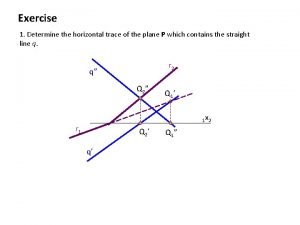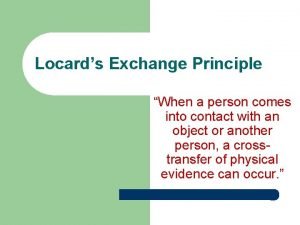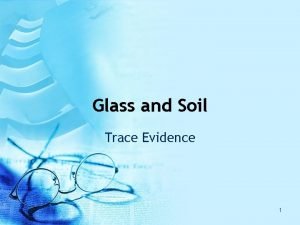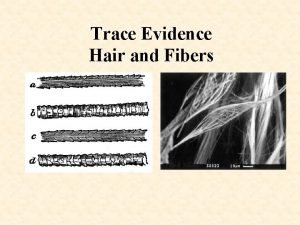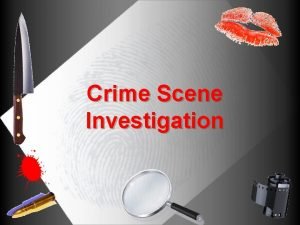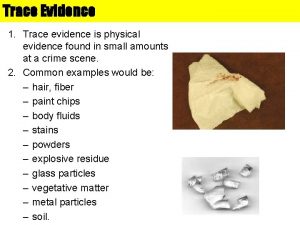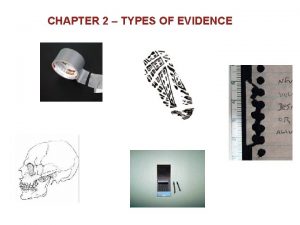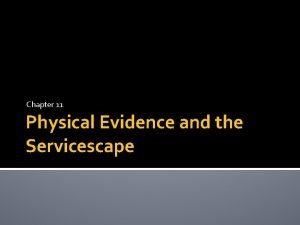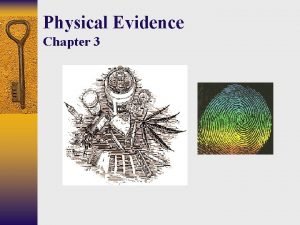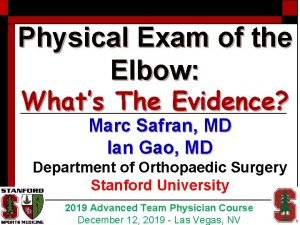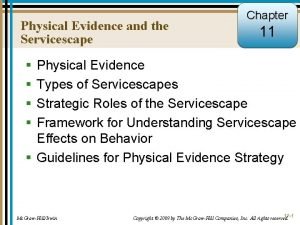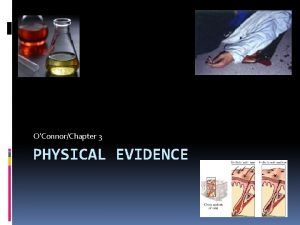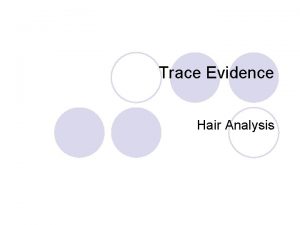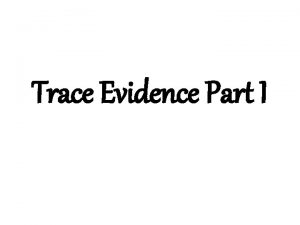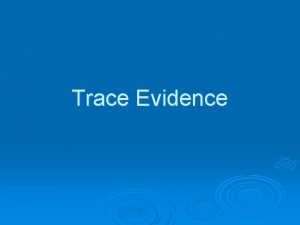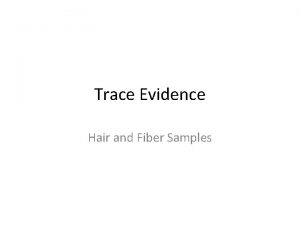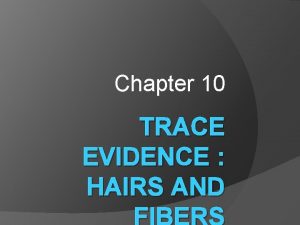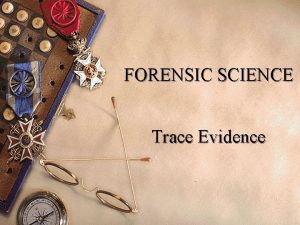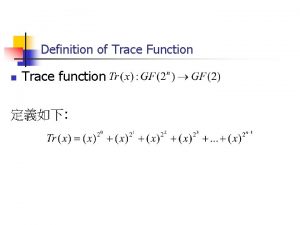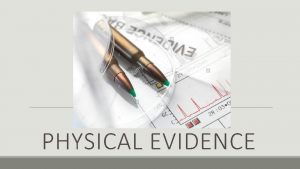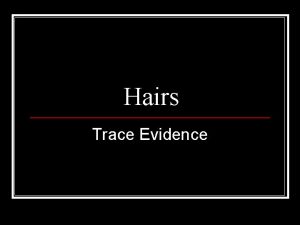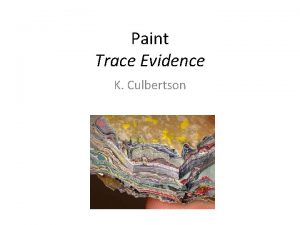Trace Evidence 1 Trace evidence is physical evidence

















- Slides: 17

Trace Evidence 1. Trace evidence is physical evidence found in small amounts at a crime scene. 2. Common examples would be: – hair, fiber – paint chips – body fluids – stains – powders – explosive residue – glass particles – vegetative matter – metal particles – soil.

Unusual Types of Trace Evidence 1. A torn piece of paper 2. Itching powder 3. Ashes 4. A spider 5. A match 6. Grease 7. Linoleum

Physical and Chemical Properties 1. Physical property: A characteristic that does not involve a change in the identity of a substance, such as odor, color, boiling point, density, refractive index 2. Chemical property: A characteristic that determines how a substance will change into another substance with different physical properties

Metal Analysis Bits of metal can be identified from their physical and chemical properties. 1. Solid particles—microscopic examination, magnetism, malleability, density, color, solubility, reactivity 2. Dissolved metals—separation by chromatography with comparison of Rf values to known metals, specific reactions, and color tests

Product Liability Solid metal particles are found in a loaf of bread. 1. Were they in the flour from the manufacturer? 2. Or were they introduced by the plaintiff for personal gain? 3. Their identity answers these questions.

Analysis of Metal Particles A Qualitative Analysis Approach

Environmental Contamination 1. Seasonal flooding caused crop failure and livestock sickness. 2. The water was tested using chromatography. 3. The separated metals had to be located on the chromatogram with UV light. 4. The spots were developed chemically and compared to standards to determine the identity of the metals.

Environmental Pollution The metals were identified, but where did they come from? 1. A magnet manufacturer? 2. A maker of brass hardware? 3. A rechargeable battery company?

Trace Evidence: Qualitative Analysis 1. When investigators find substances at the scene of a crime and send them to the laboratory for identification, the forensic chemist uses several techniques or lab tests to identify them. 2. One of these techniques is qualitative analysis. 3. For example: A number of white powders that appear the same can be identified by their physical and chemical properties.

Qualitative Analysis Microscopic Examination

Qualitative Analysis, continued Check for: 1. Solubility 2. p. H 3. Chemical reactions • Color • Precipitate formation • Evolution of gas

Flame Colors 1. Many metal salts show a distinct color when heated. 1. Sometimes this property can be used in an analysis.

A Historical Crime 1. In 1912, Emile Gourbin was a bank clerk in Lyons, France. He came under suspicion of strangling his girlfriend, Marie Latelle. Gourbin was arrested but had what appeared to be an airtight alibi. 2. Edmond Locard went to Gourbin’s cell and removed scrapings from under his fingernails. 3. The scrapings contained tissue that possibly came from Marie’s neck, but this was not provable. 4. Locard noticed that the tissue was coated with a pink dust, which he identified as rice starch. On the particles he found bismuth, magnesium stearate, zinc oxide, and a reddish iron oxide pigment called Venetian red. 5. Examination of the face powder used by Marie revealed that a powder prepared for her by a Lyons druggist was similar in composition. 6. In these days of mass-produced face powder, this evidence would have far less significance. However, in 1912, because of the special preparation, it led to the confession of Gourbin.

A More Recent Crime 1. A bank robber was startled by an alarm just as the teller handed her the money. 2. She grabbed it and, in her haste to get away, ran smack-dab into a glass door. Nevertheless, she recovered and got away. 3. Subsequent examination of the door revealed a red lipstick imprint of the perpetrator’s mouth. 4. Police later picked up a suspect, but needed evidence to link her to the robbery. 5. Are lip prints unique enough to tie the suspect to the crime? http: //www. hbo. com/autopsy/episode_6_the_telltale_imprint. ht ml

Lip Prints 1. Lip prints are different and can be used to identify suspects. 2. There are several general patterns:

Chromatography of Lipsticks 1. The lipstick used by the suspect could also have been compared to the residue on the door. 2. Thin-layer chromatography (TLC) can be used to separate the components of a lipstick. 3. The chromatograms can then be compared for a possible match.

Paint 1. Paint can be used as evidence in hit-and-run cases. 1. The layers of different paints in a cross section may be unique.
 Vertical trace and horizontal trace
Vertical trace and horizontal trace Locard's exchange principle diagram
Locard's exchange principle diagram Trace evidence examples
Trace evidence examples Trace evidence soil
Trace evidence soil Hair and fiber evidence
Hair and fiber evidence Small amounts of trace evidence can be conveniently
Small amounts of trace evidence can be conveniently Trace evidence examples
Trace evidence examples Pricing tripod in service marketing
Pricing tripod in service marketing Physical fitness components and tests grade 9
Physical fitness components and tests grade 9 Classification of physical evidence
Classification of physical evidence All aspects of the organization's physical facility
All aspects of the organization's physical facility Advantages of class physical evidence
Advantages of class physical evidence Testimonial evidence
Testimonial evidence Whats physical evidence
Whats physical evidence Physical evidence examples
Physical evidence examples Types of servicescape
Types of servicescape Individual characteristics examples
Individual characteristics examples Slidetodoc.com
Slidetodoc.com
